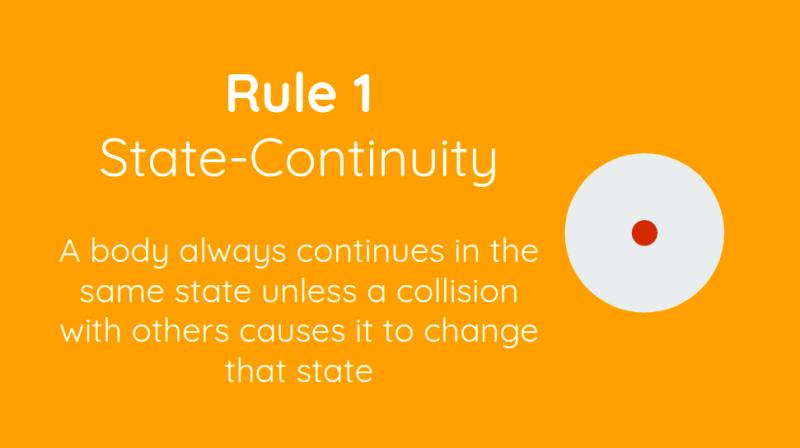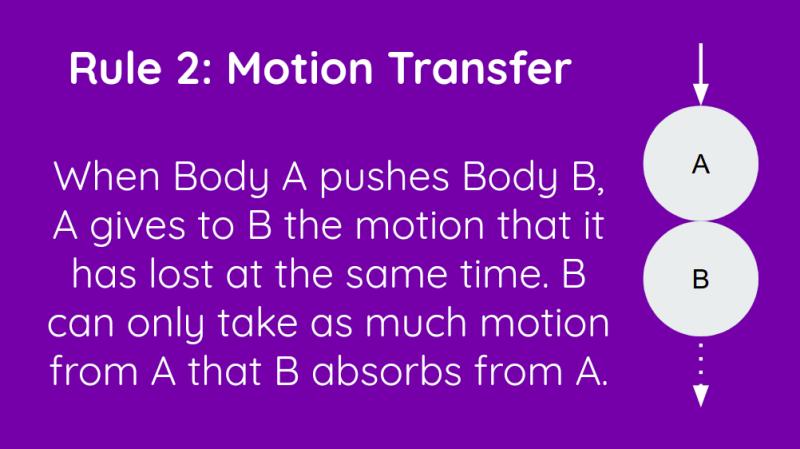The Three Rules of Nature of the Aethereal Universe
6 minutes • 1166 words
Table of contents
How could Nature untangle the confusion of the chaos after creation? What are the laws of nature that God has imposed on her?
“Nature” here does not mean some deity or imaginary power. “Nature” here means the aether itself, having the all the qualities that I have attributed to it, with the assumption that God continues to preserve it in the same way that He created it.
The fact that there are many changes in the aethereal particles that are not caused by the action of God (because that action does not change) means that those changes are from nature as the aether itself.
- It follows that God continues to preserve the aether.
- The rules on how the changes in the aether take place I call the “Laws of Nature”
Let us recall that the particles of the aether:
- have naturally diverse motions ever since the beginning when they were created,
- touch one another on all sides, without any void in between
- collide with each other when they move.
Thus, God preserves them thereafter in the same way that He created them. i.e. God always acts in the same way.
- He does not preserve them in the same state.
- But many differences occur in the effects, as if by accident
Among these Laws of Nature are 3 rules of motion.
Rule 1: State Continuity

Rule 1: A particle always continues in the same state unless a collision with others causes it to change that state.
- if a part has some size, it will become smaller only if others divide it.
- if it is round or square, it will only change that shape if others force it to do so
- if it is stopped in some place, it will only depart from that place if others chase it away
- if it begins to move, it will always continue with an equal force to move until others stop or retard it
This rule applies both in the aethereal world and in our own real world.
But the philosophers have exempted motion from it. But motion is exactly what I want to add, without intending to contradict them.
However, the motion of that philosophers speak of is so very different from that which I am explaining.
They themselves admit that the nature of their motion is very little understood. They try to explain motion as:
These words are so obscure that I cannot interpret them from Latin.
(The words “motion is the act of a being in potency, insofar as it is in potency,” are no clearer* in [English].)
*Superphysics note: In the philosophical motion, the potency is the possibility to be in other states. This actually matches the 1st Rule of Descartes. An example is the motion or movement from sadness to happiness. The motion can only take place if there was a potency of happiness. The act of being in that potency results in motion. Similarly, an immovable thing has no potency for movement and so has no motion.
On the contrary, the motion which I speak of can be known by geometers based on their surfaces and lines.
- A point’s motion forms a line.
- A line’s motion forms a surface.
The philosophers also suppose several motions that happen without the body changing place, such as:
- “motus ad formam” or motion with respect to form
- “motus ad calorem” or motion with respect to heat
- “motus ad quantitatem” or motion with respect to quantity
- and myriad others
My ‘motion’, on the other hand, refers to the lines of geometers. It is the [linear, sequential] motion taken by bodies passing from one place to another, successively occupying all the spaces in between.
The philosophers:
- say that rest is nothing but the privation of motion
- give so much solidity and reality to even the smallest motion, compared to rest
My ‘rest’ is also a quality of the aether while it remains in one place, just as motion is its quality while it is changing place.[34]
The motion explained by philosophers has a strange nature.
- Other things have perfection and preservation as their goal.
- But the goal of the motion of philosophers is to achieve rest*, contrary to all the laws of nature
- It means that motion strives on its own to destroy itself.
*Superphysics note: This is because everything aims to be in the perfect, most stable state
By contrast, my ‘motion’ follows the same laws of nature, including all the qualities found in the aether. This includes qualities observed by the philosophers:
- modos et entia rationis cum fundamento in re (modes and beings of thought with foundation in the thing)
- qualitates reales (their real qualities).
These two I cannot find in the real world.
.Rule 2: Motion Transfer

Rule 2: When Body A pushes Body B, A gives to B the motion that it has lost at the same time. B can only take as much motion from A that B absorbs from A.
The combination of Rule 1 and 2 is seen in Body B starting or stopping to move by being pushed or stopped by Body A.
Why does a stone continue to move after being thrown? Why does it not continue to move always?
This is because of air resistance. The wind whistles when the stone divides the air. If we move our hand in the air, we feel the air impeding its motion.
Rule 1 might persuade us that the more an opposing body can resist, the more it can stop the motion of others. But it cannot explain:
- why the stone’s motion is weakened more in colliding with a soft body of middling resistance than when it collides with a harder one that resists it more
- why, as soon as it has made a little effort against the harder one, it spontaneously turns on its heels rather than stopping
This is solved by Rule 2.
It teaches us that the motion of Body A is not retarded by a collision with Body B in proportion to how much Body B resists Body A, but only in proportion to:
- how much the resistance of
Body Bis surmounted, and - how much force
Body Breceives from the motion ofBody A, thatBody Aloses.[35]
Sometimes, we are unable to see that the motion of a physical body was caused by another body. But it does not mean that Rule 1 and 2 were absent.
It is possible that physical objects are moved by the fire-aether [as electromagnetism] or by the air-aether [as telekenisis?] since these two are always in physical objects. These 2 Elements can even transfer their agitation to the physical air or to the Earth itself without being perceived.
Rules 1 and 2 arise alone from the fact that God is immutable, acting always in the same way, always producing the same effect.
- The immutability and consistency of God is the reason why Rules 1 and 2 hold.






